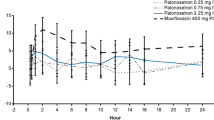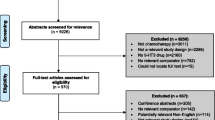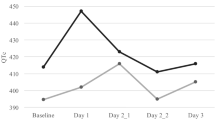Abstract
Objectives
The 5-hydroxytryptamine 3 receptor antagonists, including tropisetron, ondansetron, granisetron, and dolasetron are agents used effectively for supportive care. They are used for the prevention and treatment of chemotherapy and radiotherapy-induced emesis. Despite their overall excellent safety profile, some electrocardiographic changes related to heart rate and repolarization were reported. Ondansetron, granisetron, and dolasetron were studied on this manner. But to our knowledge, there is no information about the cardiac side effects of tropisetron. In this study, we aimed to determine the acute effects of tropisetron on ECG parameters related to repolarization, heart rate, and systemic blood pressure.
Materials and methods
Fifty-five cancer patients who received tropisetron for the prevention of acute chemotherapy-induced nausea and vomiting were enrolled into this single center, prospective study. Standard 12-lead ECG recordings were performed at baseline and 30 min after tropisetron (5 mg given over 1 min IV bolus) administration. P wave durations and corrected QT intervals were measured; P wave dispersion and QTc dispersion were calculated.
Results
In comparison with baseline, mean heart rate significantly decreased 30 min after administration of tropisetron. Tropisetron did not result in a significant change in P wave duration, corrected QT interval, P dispersion, and QTc dispersion.
Conclusion
In this study, tropisetron did not show any ventricular and atrial arrhythmogenic effect because of repolarization abnormalities. Only it may cause a slight decrease in heart rate.
Similar content being viewed by others
References
Aapro M, Bourke JP (2003) Rapid intravenous administration of granisetron prior to chemotherapy is not arythmogenic: results of a pilot study. Eur J Cancer 39(7):927–931
Antzelevitch C, Yan GX, Shimizu W (1999) Transmural dispersion of repolarization and arrhythmogenicity: the Brugada syndrome versus the long QT syndrome. J Electrocardiol 32(Suppl):158–165
Audhuy B, Cappelaere P, Martin M et al (1996) A double-blind, randomised comparison of the anti-emetic efficacy of two intravenous doses of dolasetron mesilate and granisetron in patients receiving high dose cisplatin chemotherapy. Eur J Cancer 32A(5):807–813
Ballard HS, Bottino G, Bottino J (1992) Ondansetron and chest pain. Lancet 340(8827):1107
Bazett HR (1920) An analysis of the time relations of electrocardiographs. Heart 7:353–370
Benedict CR, Arbogast R, Martin L et al (1996) Single-blind study of the effects of intravenous dolasetron mesylate versus ondansetron on electrocardiographic parameters in normal volunteers. J Cardiovasc Pharmacol 28(1):53–59
Boike SC, Ilson B, Zariffa N et al (1997) Cardiovascular effects of i.v. granisetron at two administration rates and of ondansetron in healthy adults. Am J Health Syst Pharm 54(10):1172–1176
Buyukavci M, Olgun H, Ceviz N (2005) The effects of ondansetron and granisetron on electrocardiography in children receiving chemotherapy for acute leukemia. Am J Clin Oncol 28(2):201–204
Chen A, Kusumoto FM (2004) QT dispersion: much ado about something. Chest 125(6):1974–1977
Day CP, McComb JM, Campbell RW (1990) QT dispersion: an indication of arrhythmia risk in patients with long QT intervals. Br Heart J 63(6):342–344
Gialafos JE (1999) P-wave dispersion. Eur Heart J 20(4):317
Gray GW, McLellan TM, Ducharme MB (1996) Granisetron shows no pro-arrhythmic effect in normal subjects during or after exercise in a hot environment. Aviat Space Environ Med 67(8):759–761
Hesketh P, Navari R, Grote T et al (1996) Double-blind, randomized comparison of the antiemetic efficacy of intravenous dolasetron mesylate and intravenous ondansetron in the prevention of acute cisplatin-induced emesis in patients with cancer. Dolasetron Comparative Chemotherapy-induced Emesis Prevention Group. J Clin Oncol 14(8):2242–2249
Hunt TL, Cramer M, Shah A et al (1995) A double-blind, placebo-controlled, dose-ranging safety evaluation of single-dose intravenous dolasetron in healthy male volunteers. J Clin Pharmacol 35(7):705–712
Jantunen IT, Kataja VV, Muhonen TT et al (1996) Effects of granisetron with doxorubicin or epirubicin on ECG intervals. Cancer Chemother Pharmacol 37(5):502–504
Keefe DL (2002) The cardiotoxic potential of the 5-HT(3) receptor antagonist antiemetics: is there cause for concern. Oncologist 7(1):65–72
Kuryshev YA, Brown AM, Wang L et al (2000) Interactions of the 5-hydroxytryptamine 3 antagonist class of antiemetic drugs with human cardiac ion channels. J Pharmacol Exp Ther 295(2):614–620
Lofters WS, Pater JL, Zee B et al (1997) Phase III double-blind comparison of dolasetron mesylate and ondansetron and an evaluation of the additive role of dexamethasone in the prevention of acute and delayed nausea and vomiting due to moderately emetogenic chemotherapy. J Clin Oncol 15(8):2966–2973
Morganroth J (2007) Cardiac repolarization and the safety of new drugs defined by electrocardiography. Clin Pharmacol Ther 81(1):108–113
Morganroth J (2007) Evaluation of the effect on cardiac repolarization (QTc interval) of oncologic drugs. Ernst Schering Res Found Workshop (59):171–184
Navari RM (2003) Pathogenesis-based treatment of chemotherapy-induced nausea and vomiting—two new agents. J Support Oncol 1(2):89–103
Perkiomaki JS et al (1997) Heart rate variability and dispersion of QT interval in patients with vulnerability to ventricular tachycardia and ventricular fibrillation after previous myocardial infarction. J Am Coll Cardiol 30(5):331–338
Schnell FM (2003) Chemotherapy-induced nausea and vomiting: the importance of acute antiemetic control. Oncologist 8(2):187–198
Author information
Authors and Affiliations
Corresponding author
Rights and permissions
About this article
Cite this article
Yavas, O., Yazici, M., Eren, O. et al. The acute effect of tropisetron on ECG parameters in cancer patients. Support Care Cancer 16, 1011–1015 (2008). https://doi.org/10.1007/s00520-007-0400-2
Received:
Accepted:
Published:
Issue Date:
DOI: https://doi.org/10.1007/s00520-007-0400-2




